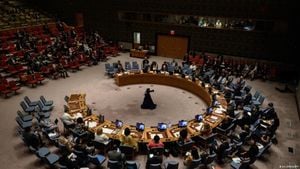Thailand’s capital, Bangkok, has recently experienced notable improvements in its PM2.5 air pollution crisis, providing much-needed relief to residents. Reports indicate the average level of particulate matter 2.5 (PM2.5) has decreased to 23.1 micrograms per cubic meter as of February 25, 2023. This improvement is attributed to favorable meteorological conditions, including forecasts of rain over the next several days, which are expected to help disperse harmful air pollutants.
According to the Bangkok Air Quality Data Center, the air quality levels across the city were reported to be predominantly within acceptable ranges, with indications of significant reduction from previous weeks. Notably, the Thonburi area recorded the highest PM2.5 levels at 31.8 micrograms per cubic meter, closely followed by the Nong Kham district with similar readings. These areas are traditionally the hardest hit by air pollution due to heavy traffic and industrial activities.
Environmental experts have noted the correlation between rain and improved air quality, as precipitation helps wash out airborne particulates. A spokesperson from the Department of Environmental Quality Promotion stated, "The air quality is good, and there’s potential for rain, which can help reduce dust levels." Such statements provide reassurance to citizens who have been battling the severe impacts of air pollution on their daily lives.
Residents across Bangkok have expressed relief over the current air quality status. With the anticipated rain forecasted to last from February 26 until March 1, the public's hope is buoyed for continued improvement. The city’s environmental authorities have urged citizens to remain vigilant, advising them to check air quality reports before venturing outside, especially on days where pollution levels might fluctuate due to weather changes.
This latest report serves to highlight the dynamics of Bangkok’s air quality issues throughout the year, where seasonal changes and political will affect pollution management strategies. Historically, the city has contended with chronically high levels of PM2.5, associated with health ailments related to respiratory problems, increased hospital admissions, and overall declines in public health quality.
It is encouraging to observe the joint efforts from governmental bodies and environmental groups focused on addressing air quality issues. Continuous monitoring and the release of timely updates are seen as necessary measures to inform the public and safeguard community health.
The dialogue surrounding air pollution has often centered around the urgencies of immediate actions and long-term strategies. Local activists have pushed for stronger regulations on emissions from factories, construction sites, and vehicle exhausts, underscoring the necessity for cleaner air standards. One such activist echoed the sentiments of many by stating, "We advise citizens to check the air quality before going out, especially during this fluctuated period." This advocacy is pivotal as awareness is key to formulating community response strategies.
While current air conditions may be healthier, the looming question remains what long-term measures are being taken to mitigate similar crises. Recent months have seen various initiatives from local governments targeting positive changes, yet, it’s widely acknowledged more aggressive actions are needed to confront the root causes of air pollution.
Moving forward, public discourse should not only revolve around temporary relief measures during rain periods but must also focus on sustainable solutions including urban planning adjustments, investments in public transport infrastructure, and support for green energy initiatives. Only through comprehensive efforts can they hope to sustain improvements rather than experiencing cyclical pollution crises as seen previously.
Overall, the present moment reflects both hope and urgency. With PM2.5 levels trending downwards, residents are encouraged to remain aware and proactive about their health. The forthcoming weeks, amplified by cooperative weather, offer a unique opportunity for the city to breathe easier, but the responsibility lies with lawmakers and stakeholders to implement enduring strategies for cleaner air.



